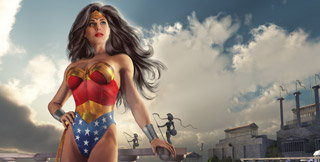User Stories
CHARACTER DESIGN
DOUGLAS SHULER
Douglas Shuler has been a freelance artist for 25 years, originally trained in classic art mediums such as pencils and oil paints. He was first exposed to computer art in the mid '90’s with what began as occasional dabbling and rare Photoshop fixes has now become a full-time career with 3D art, rendering, compositing, photo-retouching, and digital over-paints. Douglas has worked for numerous game and media companies including TSR, Wizards of the Coast, Lucasfilm, Paramount Pictures and the Sci-Fi Channel. Embracing computer art, Doug has all but abandoned traditional methods and now makes extensive use of Daz 3D figures for most of his creations.
TOOLS USED
DAZ Studio, Adobe® Photoshop
FAVORITE DAZ 3D PRODUCTS
Michael, Victoria
Douglas Shuler in action
HOW DOUGLAS SHULER USES DAZ 3D PRODUCTS
"Whenever I start a new project, I begin with a stack of rough sketches. Although I can usually 'see' the image in my mind, I want to nail down the composition as tightly as possible so I can best evaluate what steps, models, and processes I might need. I consider this step to be a lot more in-depth than the usual set of rough sketches artists typically perform, because I'm not just working with line and space; I'm also working out what models to use, where to place lights, what textures I'll need to create, what hairstyles might be available, and other technical details.
This is when I usually hit the Daz 3D website and browse through the available models. The available templates make them very easy to re-texture. I think I've created over 400 characters so far. After setting up the core character and bodysuit, I look over what other assets are needed by way of hairstyles, gloves, boots, belts, jackets, or armor. I start mentally building the character and taking notes about what models I'll need to finish the scene. Once I have the core character built, I start to create test poses to evaluate the validity of my idea. What looks good on paper doesn't always translate well into a 3D model. The computer won't let you cheat. I move legs, reposition arms, and angle the head as needed to capture the same 'feel' as in the roughs. This part can be difficult and frustrating because I'm very picky about getting the pose to be expressive without being unnatural. My desire is to ensure the character is expressed through body language. I often move lights around and play with specific render settings. I am a strong believer in post-work and will often create a character in a 'bare-bones' setting, sometimes rendering the character completely bald.
The strength of Daz 3D models is that very little work is needed to really make the render shine. The high-resolution textures and pre-modeled wrinkles in clothing greatly contribute to an artist's ability to create incredible renders with minimal work. Throughout my career, I have purchased models from various online brokers and the quality has varied greatly from models that didn't conform properly, missing textures, to misleading promotional shots and incomplete geometry. However, when it comes to items I find within the Daz 3D catalog, I've never had a quality issue with a Daz 3D product.
The final stage is brought to a finish by adding in whatever elements remain through Photoshop post-work. Depending on the amount of rework needed, the renders often take on the appearance of a painting. Backdrops are composited from separate renders; clothing is enhanced with more wrinkles or details, plants composited in, and in the case of “Poison Ivy,” photo-reference is used to recreate her face. Altogether, a piece can take between 10 and 30 hours of effort."







